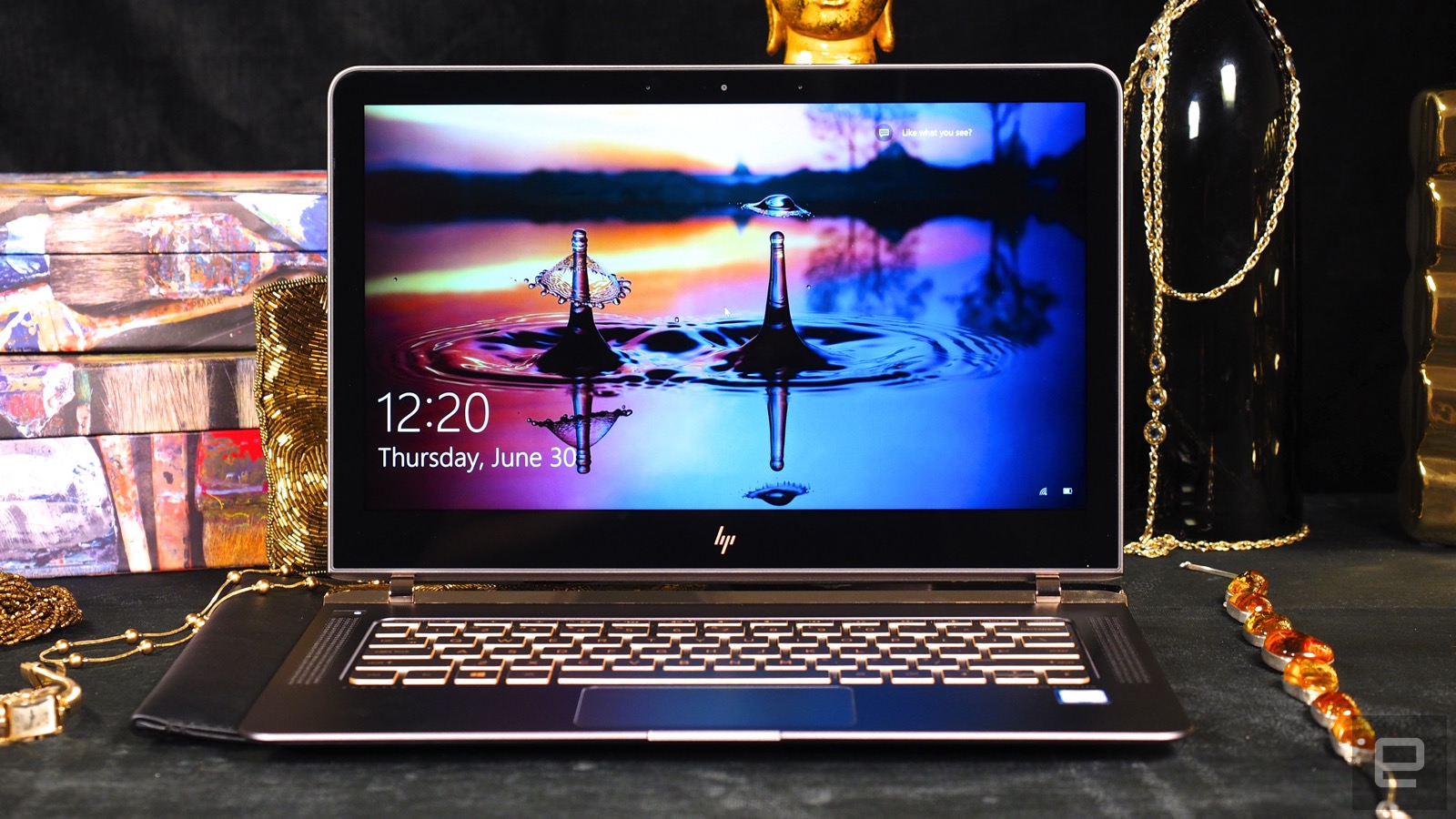The Spectre 13.3 is the most intriguing thing HP has made in years
It’s been a long time since I’ve wanted to test a laptop this badly. The HP Spectre 13.3 isn’t just the world’s thinnest notebook; it’s the most exciting device Hewlett-Packard has made in years. I mean, just look at it. The 10.4-millimeter-thick, 2.45-pound PC is as slim as a AAA battery, with a sleek new logo and copper accents inspired by classic watches.
Aside from being the skinniest notebook on the planet, the Spectre 13.3 differs from its closest competitors in a few other key ways: It brings a cushier keyboard, a more powerful processor and a larger selection of ports, including a USB-C adapter in the box. (Hear that, Apple?) The idea that HP produced not just a MacBook rival but one that has a distinctive design and potentially learns from Apple’s mistakes makes it very interesting indeed. After using it for two weeks, I can confirm it’s largely worthy of the hype. But it’s clear that in the interest of building a thin, fast PC, HP made some compromises of its own.
Gallery: HP Spectre 13 review | 22 Photos
Engadget Score
Pros
- Distinct, modern design
- World’s thinnest laptop (and lightweight too)
- Comfortable keyboard
- Fast performance for a machine in this class
- Chassis doesn’t overheat
- Reasonable starting price compared to the competition
Cons
- Fan can get noisy
- Jumpy trackpad
- Non-touch screen with lower resolution than rival machines
- Faster processor means a dip in battery life compared to competing systems
Summary
In the pursuit of building the world’s thinnest laptop, HP both improved on its rivals while also introducing a different set of trade-offs.
Hardware

I imagine the Spectre 13’s design will be polarizing: Some will love it and others will hate it, but few will be indifferent. Really, though, I suspect most people will love it. If my own experience is any indication, plenty of people have stopped by desk, curious about the strange laptop I had lying around. Everyone wants to examine it, and many even say they’d buy one. That includes a lot of dudes too — despite the fact that those copper accents were inspired in part by women’s jewelry, according to HP.
All told, the company’s design team got a couple of things right here, aside from the sheer thinness and lightness. The gender-neutral thing is one of them. The Spectre 13 is neither masculine nor feminine, just … nice. Expensive-looking. I think it’s the fact that the brownish color (HP calls it Dark Ash) offsets the elegant copper accents and clutch-shaped chassis. It’s a timeless color palette that, depending on your point of view, evokes either jewelry or classic timepieces. Either way, there’s no question this is a premium device. Best of all — and this is another area where HP deserves credit — the Spectre 13 has a look that’s thoroughly, refreshingly unique. Nobody can accuse the company of copying or stealing.
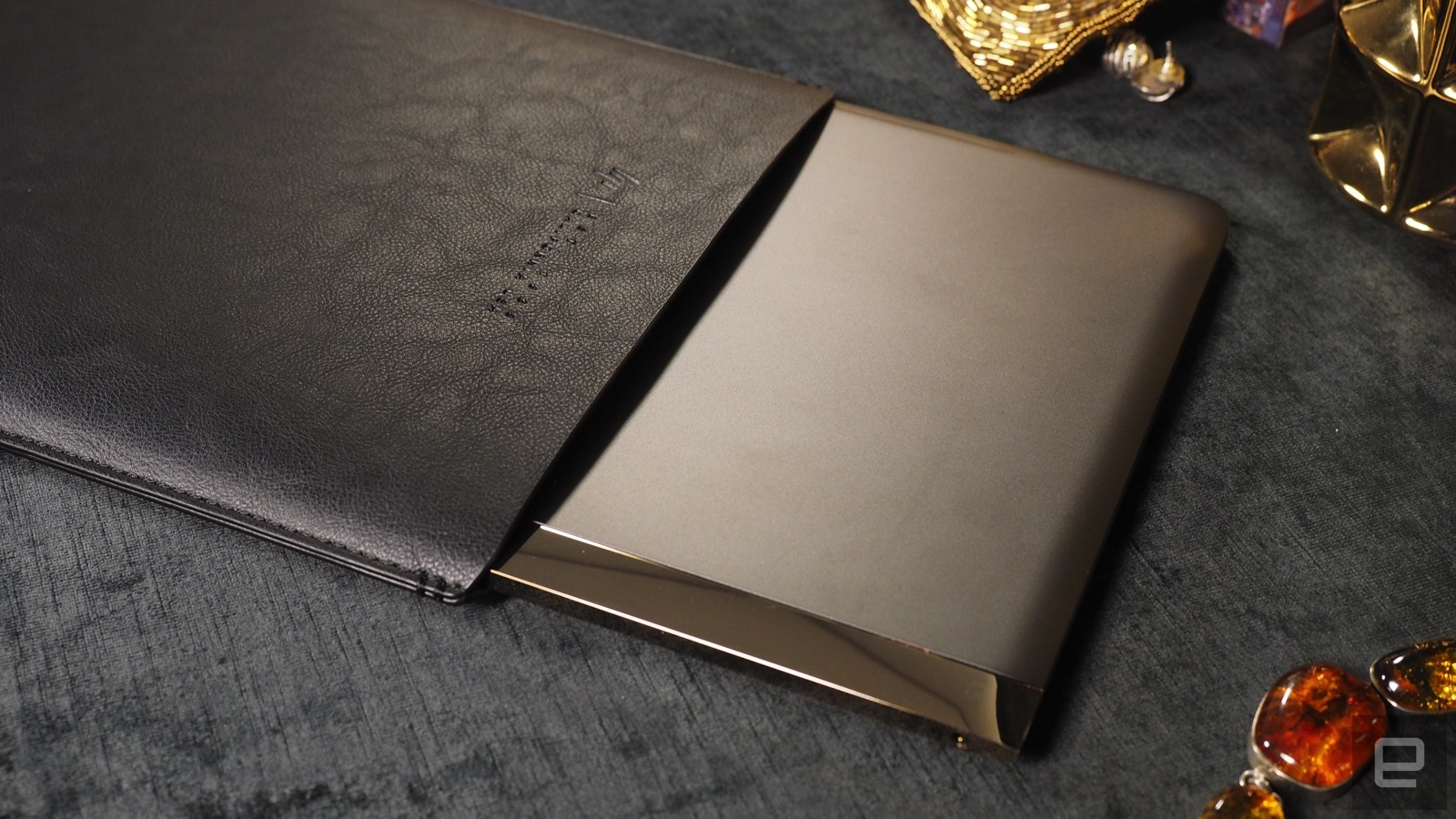
There are other cues too, aside from the color scheme. As light as the system is, the carbon fiber makes it feel sturdy in hand. A leather sleeve comes in the box — a nice touch. For this machine, HP went with higher-quality Bang & Olufsen audio. Additionally, the Spectre 13’s hinge has a smooth, controlled feel that HP says was inspired by high-end cabinetry. I also like the way the screen sort of floats above the keyboard deck, and the fact that the bezels are only a few millimeters thin. (I’ve seen non-touch displays on other laptops with about an inch of useless space framing the panel.)
The copper accents also have the feel of a fine wristwatch, not just the metallic color. The thing about that, though, is that in order for HP to replicate the texture of jewelry, it had to forgo any sort of oil-resistant coating. It looks authentic, for both better and worse — complete with fingerprints. Be prepared to either wipe them down frequently or resign yourself to not caring.
Speaking of the screen, by the way: No, it doesn’t support touch. That’s a shame — I’ve grown used to tapping the display on Windows machines when I want to do things like shut down the system — but it was a necessary compromise to make the device as thin as it is. (Whether the device needed to be as slim as a AAA battery is up for debate.) The screen is also low-res compared with other panels on the market, with a maximum resolution of 1,920 x 1,080.
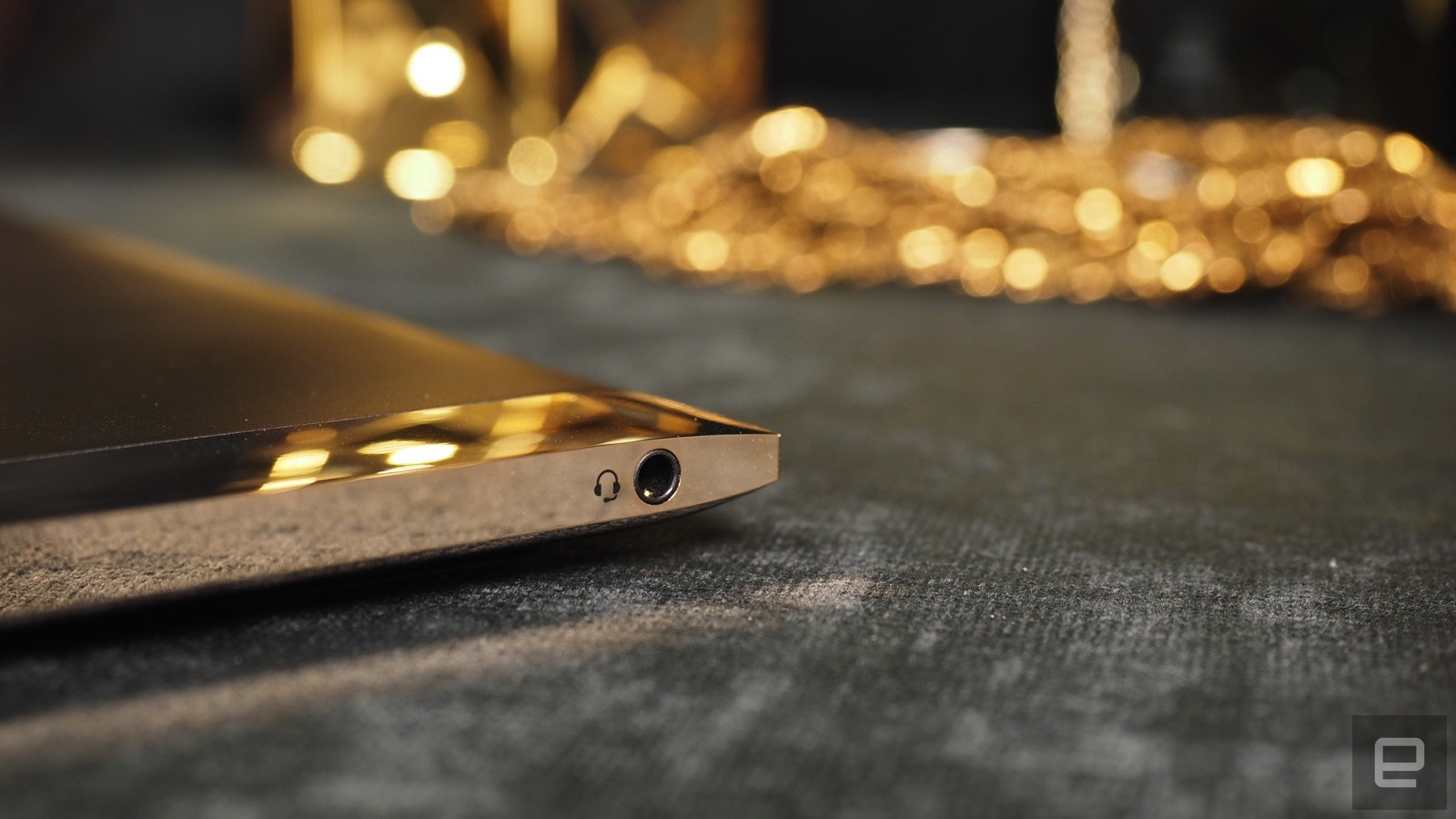
That’s actually fine for a display this size, and besides, a more pixel-dense panel would have further drained the battery life, especially if HP were committed to using Core i processors instead of Core M. (The 12-inch MacBook has a 2,304 x 1,440 Retina display with a Core M processor. The battery life is longer, but performance is slower. Not sure who wins.) In any case, resolution aside, the colors here are pleasant and the viewing angles wide, which is really the most important thing.
What the Spectre 13 lacks in pixels, it potentially makes up for in ports. Whereas the MacBook has one measly USB Type-C socket, the Spectre 13 brings three of them, and there’s a handy USB-C-to-USB-A dongle in the box, in case you still have a phone, hard drive or some other peripheral whose cable was designed for full-size USB connections. (Chances are you do.) HP also sells optional Ethernet and HDMI dongles for $50 apiece.
All of those ports, by the way, are stacked along the back edge. HP says its customers asked for this. I don’t doubt that, though I also know many people (myself included) who would prefer to have at least some of them on the side, for easier access. Can’t please everybody, I guess.
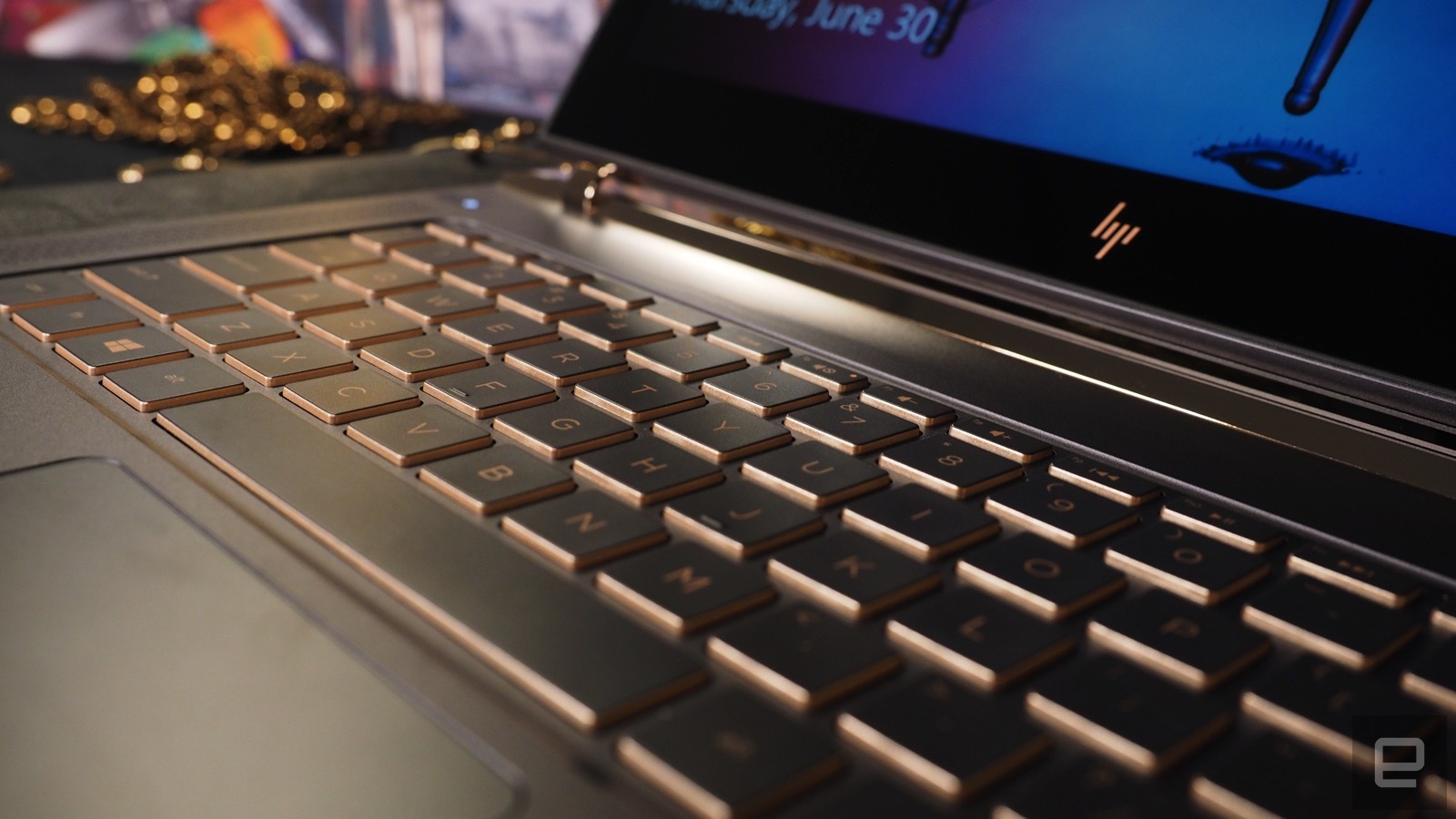
Finishing up our tour on a very important note, I like typing on the Spectre 13. As thin as the machine itself is, the keys offer 1.3 millimeters of travel, which isn’t bad for a laptop in this class. Between the relative cushiness, the generous key size and the spacing between the buttons, there wasn’t much of a learning curve. I wish I could say the same about the Synaptics trackpad, though. The problems I encountered included some friction in single-finger tracking as well as unintended left clicks, causing me to do things like drag pinned tabs when I didn’t mean to. These issues aren’t unique to either Synaptics or HP, but to the extent that the touchpad is a main input device, especially on a laptop with no touchscreen, a jumpy pad is disappointing.
Performance and battery life
| PCMark 7 | PCMark 8 (Creative Accelerated) | 3DMark 11 | 3DMark (Sky Diver) | ATTO (top reads/writes) | |
|---|---|---|---|---|---|
| HP Spectre 13 (2.5GHz Intel Core i7-6500U, Intel HD 520) | 5,046 | 3,747 | E2,790 / P1,630 / X375 | 3,810 | 1.61 GB/s / 307 MB/s |
| Huawei MateBook (1.1 GHz Core M3, Intel HD 515) | 3,592 | 2,867 | E1,490 / P887 | 2,454 | 538 MB/s / 268 MB/s |
| Lenovo ThinkPad X1 Tablet (1.2 GHz Core M7-6Y75, Intel HD 515) | 4,951 | 3,433 | E1,866 / P1,112 | 2,462 | 545 MB/s / 298 MB/s |
| Dell XPS 13 (2.3GHz Core i5-6200U, Intel Graphics 520) | 4,954 | 3,499 | E2,610 / P1,531 | 3,335 | 1.6GB/s / 307 MB/s |
| Razer Blade Stealth (2.5GHz Intel Core i7-6500U, Intel HD 520) | 5,131 | 3,445 | E2,788 / P1,599 / X426 | 3,442 | 1.5 GB/s / 307 MB/s |
| Toshiba Radius 12 (2.5GHz Intel Core i7-6500U, Intel HD 520) | 5,458 | 3,684 | E2,865 / P1,622 | 3,605 | 552 MB/s / 489 MB/s |
| Microsoft Surface Pro 4 (2.4GHz Core i5-6300U, Intel HD 520) | 5,403 | 3,602 |
E2,697/ P1,556/ X422 |
3,614 | 1.6 GB/s / 529 MB/s |
| Lenovo Yoga 900 (2.5GHz Core i7-6500U, Intel HD 520) | 5,368 | 3,448 |
E2,707 / P1,581 |
3,161 | 556 MB/s / 511 MB/s |
I tested one of the Spectre 13’s higher-end configurations, with a 2.5GHz dual-core Core i7-6500U processor and 8GB of RAM (actually, all of the available models have eight gigs of memory). This is going to shock you, I know, but that Core i7 chip just creams the MacBook and other Core M–powered machines in synthetic benchmarks. Because the Samsung-made solid-state drive here is of the PCIe variety, you can expect faster read speeds than in the competition — average highs of 1.61GB per second in my tests. Thanks in part to that SSD, the machine boots up in a brisk nine seconds. Weirdly, though, write speeds were actually on the low end, according to the ATTO test, with rates topping out at 307 MB/s. That’s hardly terrible; just lower than what I’d expect for a PCI drive.
Regardless, the Spectre 13 was up to the task of serving as my full-time work/play machine, with Slack, Spotify and a dozen Chrome tabs always open. That might not sound like a lot, but that’s workload enough to choke other, lesser-specced machines.
All of that performance muscle comes at a cost, though: fan noise. Lots and lots of fan noise. Setting aside graphics tests like 3D Mark, which would get even dedicated gaming notebooks whirring, even mundane tasks like installing Slack caused the machine to pipe up.
At least the fans do their job. Because the Spectre 13 is as small and light as it is, I got in the habit of carrying it around in one hand, balanced on my palm with the screen open. It was a convenient setup for shuffling between conference rooms, and guess what? My hand never burned. The underside of the machine gets warm, sure, but never hot.
|
Battery life |
|
|---|---|
| HP Spectre 13 | 7:07 |
| Surface Book (Core i5, integrated graphics) | 13:54 / 3:20 (tablet only) |
| HP Spectre x360 (13-inch, 2015) | 11:34 |
| Surface Book (Core i7, discrete graphics) | 11:31 / 3:02 (tablet only) |
| Apple MacBook Pro with Retina display (13-inch, 2015) | 11:23 |
| iPad Pro (12.9-inch, 2015) | 10:47 |
| HP Spectre x360 15t | 10:17 |
| Chromebook Pixel (2015) | 10:01 |
| Lenovo Yoga 900 | 9:36 |
| Microsoft Surface 3 | 9:11 |
| Apple MacBook (2016) | 8:45 |
| Samsung Notebook 9 | 8:16 |
| Dell XPS 13 (2015) | 7:36 |
| Microsoft Surface Pro 4 | 7:15 |
| Huawei MateBook | 6:35 |
| Razer Blade Stealth | 5:48 |
| Dell XPS 15 (2016) | 5:25 (7:40 with the mobile charger) |
| Toshiba Radius 12 | 5:12 |
To maximize battery life in such a tiny machine, HP went with a split battery that, true to its name, is composed of multiple sections, designed to take up as much space inside the chassis as possible. All told, HP says it’s capable of lasting up to nine hours and 45 minutes in synthetic benchmark tests. In Engadget’s own test, which involves looping an HD video at fixed brightness, the laptop gave out far sooner. Under those conditions, the Spectre 13 made it through seven hours and seven minutes of video playback.
That’s not bad, exactly — the Dell XPS 13 and Surface Pro 4 turned in similar scores — but the recently refreshed MacBook made it nearly nine hours under the same testing conditions. Again, there would have been trade-offs regardless of which processor HP chose. In this case, they opted for performance over battery life, though we might have also called them out had they made the opposite compromise.
Configuration options and the competition
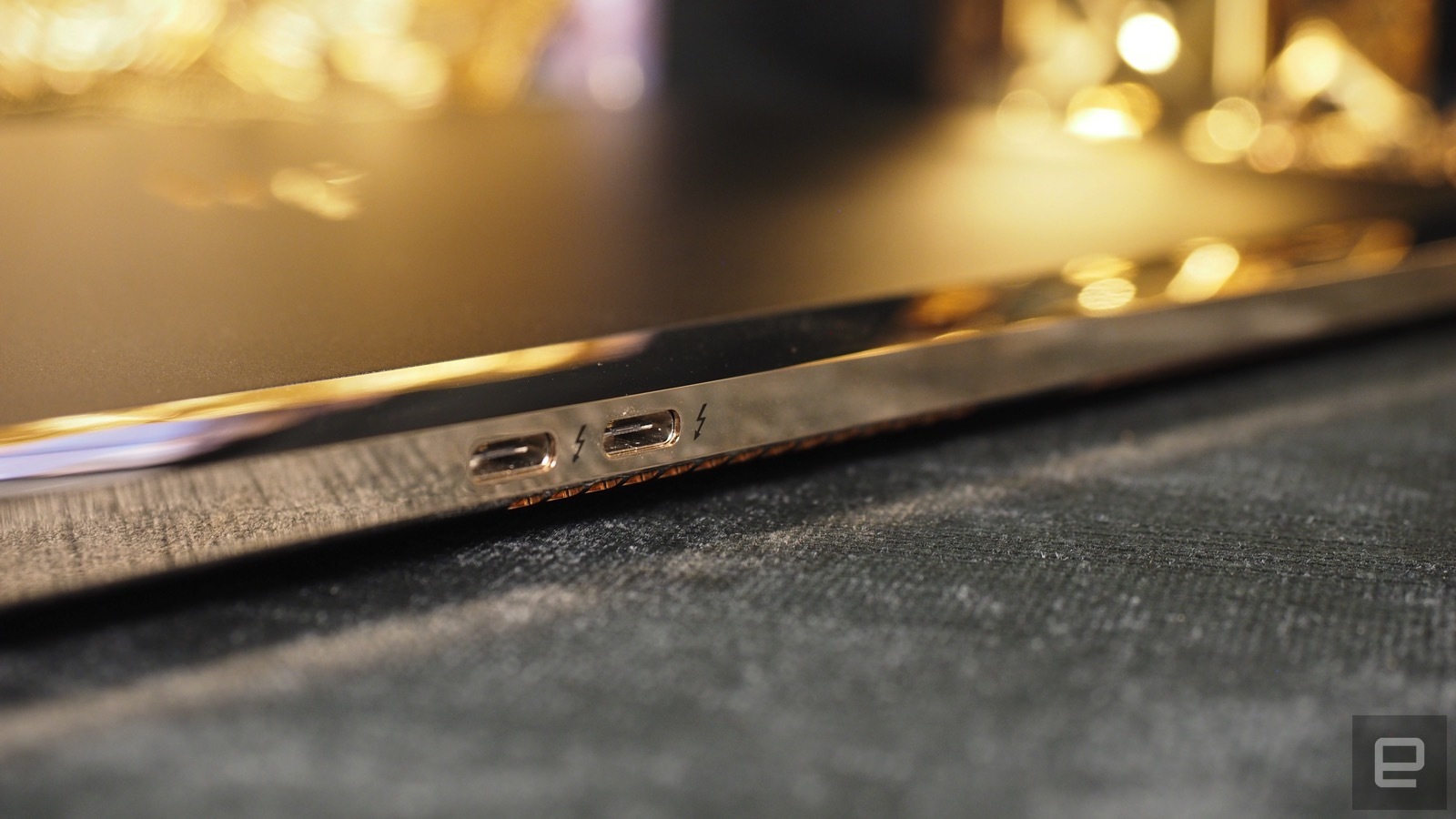
Here in the US, you can buy the Spectre 13.3 either through HP’s website or at Best Buy, if you prefer to try before you purchase. The entry-level $1,170 configuration has a Core i5 processor and 256GB SSD. The next model up, priced at $1,250, steps up to a Core i7 CPU. Finally, the top-of-the-line edition, which sells for $1,500, offers both a Core i7 chip and a larger-capacity 512GB drive. And again, all three SKUs come with 8GB of RAM.
There are a few other good options in this category — you know, an insanely thin and light laptop with a roughly 12- or 13-inch screen that’s actually a notebook, not a 2-in-1. The 12-inch MacBook, introduced last year, of course comes to mind. I think I’ve done a pretty good job laying out the trade-offs, but to recap: With the MacBook you get a higher-res screen, longer battery life, quieter performance and a more reliable trackpad, but you’re stuck with one measly port, and the performance, though acceptable, isn’t as fast as it would have been if Apple used Core i processors. That machine starts at $1,299 with a 256GB drive and 8GB of RAM, making it expensive compared with the entry-level Spectre 13.3.
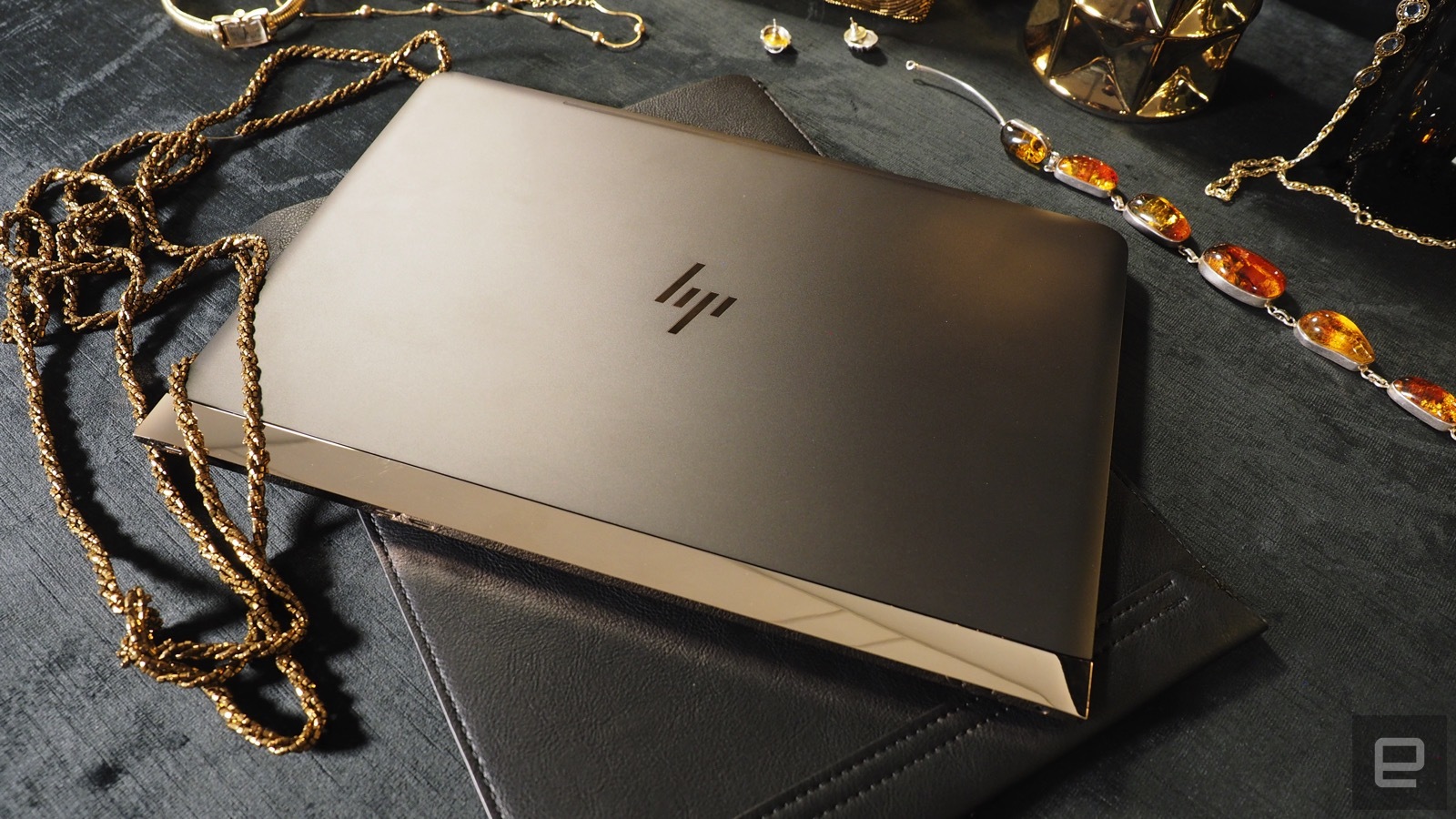
Not so fast, though: There are even more compelling options. ASUS recently unveiled the two-pound ZenBook 3, which is nearly as thin as the Spectre 13.3 and also packs Core i5 and i7 processors. Even better, it starts at a more wallet-friendly $999 (albeit with half the RAM and, like the MacBook, just one USB-C port). That’s not actually out yet, and ASUS hasn’t said when it will go on sale, so count this out if you need a new laptop right now.
And the list goes on. Dell’s XPS 13 ($800-plus) weighs 2.6 pounds and crams a 13-inch display into the chassis of a 12-inch machine. Reasons to buy it include a durable (and stylish) carbon fiber design, a comfortable keyboard, fast performance and a vibrant display. Meanwhile, some promising models we haven’t tested include the Sony VAIO Z (2.58 pounds, starting at $1,499) and the Lenovo Yoga 900 series, the lighter of which, the 900s, weighs in at 2.2 pounds with a touchscreen and starts at $1,100.
Wrap-up
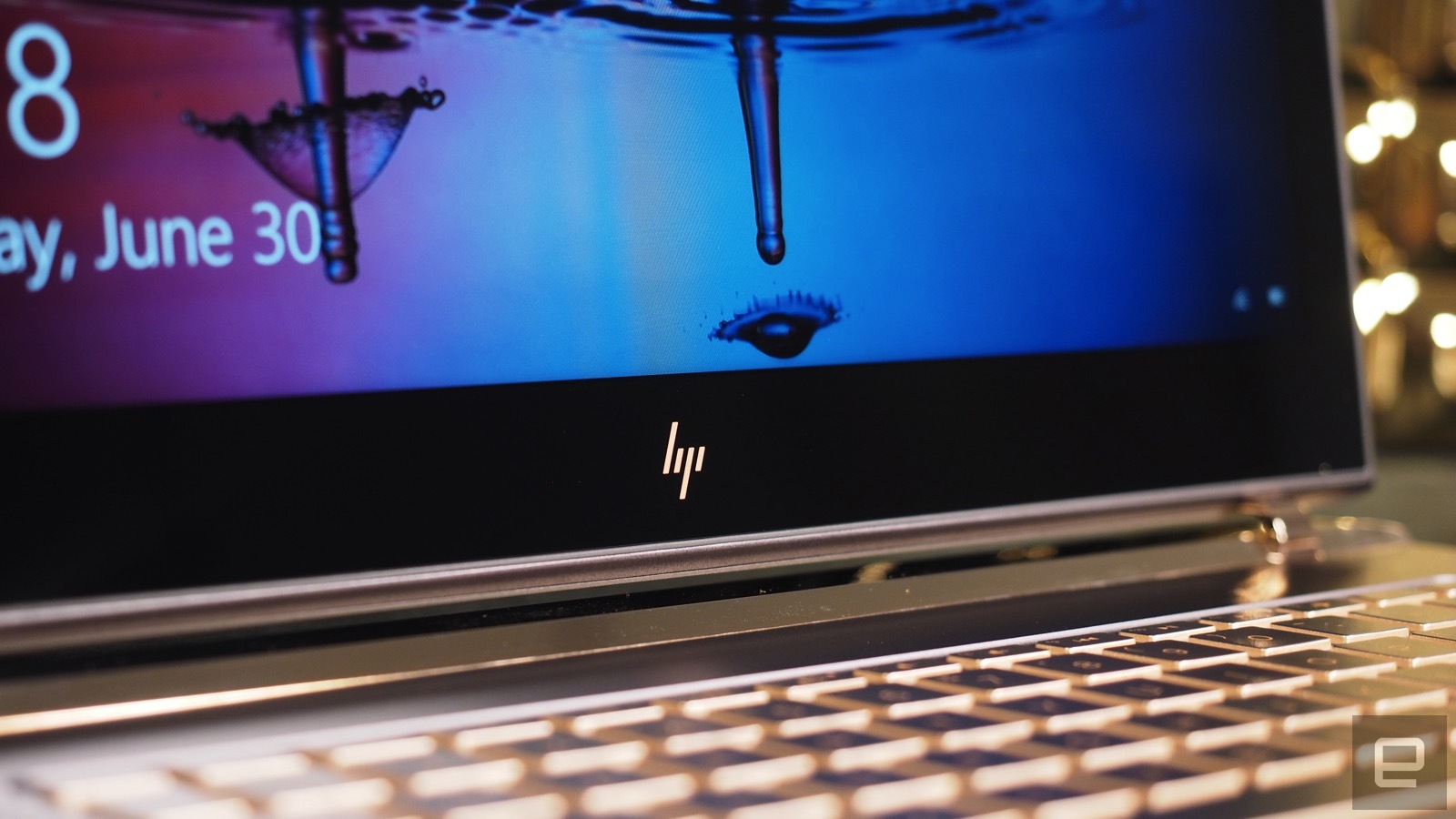
The Spectre 13.3 is almost everything I hoped it would be, but HP is no closer to creating a perfect device than its competitors are. In the pursuit of a fast and record-breakingly thin machine, HP had to make some compromises, including settling for a lower-res, non-touch display, an occasionally loud fan and a dip in battery life compared with the competition. Some of these things won’t necessarily be deal breakers: The screen is crisp enough as it is, and though the battery life isn’t best in class, it’s still acceptable. Meanwhile, I’m sure some folks will appreciate the speed boost over competing systems, especially where transfer speeds are concerned.
All of this is to say, I recommend it. Just don’t call this thing a “MacBook killer,” or a killer of anything, really. Think of it as a MacBook alternative: yet another good laptop, with its own set of trade-offs.
Photos by Edgar Alvarez
(52)



